Terminal rail-route de Nancy-Champigneulles
2.jpg)
ORT&L Grand Est
Pouvez-vous nous présenter votre structure en quelques mots ?
L’Observatoire Régional Transports et Logistique du Grand Est est une association d’une trentaine de membres publics (les administrations d’Etat et les collectivités locales) et privés (les représentants des professionnels des transports et de la logistique et les grands acteurs du fret comme les ports de Strasbourg et Lorrains, SNCF Réseau et VNF). C’est un lieu d’échanges qui produit et diffuse de la connaissance et une vision partagée sur les transports et de la logistique dans la région, né en 2017 de la fusion des trois observatoires des anciennes régions d’Alsace, Lorraine et Champagne-Ardenne. Nous disposons d’un site internet : www.ortl-grandest.fr
Quel est l’état des lieux de la supply chain dans le Grand Est ?
Le Grand Est, par sa position frontalière avec la Suisse, l’Allemagne, la Belgique et le Luxembourg, se situe au croisement des flux européens. Au plan national, l’ouest de la région porte l’atout de la proximité de l’Île-de-France. L’industrie et l’agriculture représentent 23% du PIB dans le Grand Est, alors que la moyenne française est de 16%. Cette forte activité génère de la logistique et une dynamique d’exportation qui peut s’appuyer sur deux modes de transport davantage développés dans la région qu’ailleurs sur le territoire national, le fluvial et le ferroviaire. Les chiffres d’avant la pandémie montrent que le fret ferroviaire, avec 360 trains par jour, représente un quart du fret national. Côté fluvial, le port de Strasbourg est le second port intérieur de France, Mulhouse le troisième, et celui de Metz est le premier port céréalier. 87% du volume part à l’international. Le transport routier est bien entendu largement dominant grâce à deux grands axes : l’Alsace et le sillon lorrain. Reims, Châlons-en-Champagne et Troyes sont aussi des pôles logistiques importants. Le transport et la logistique emploient environ 126.000 personnes, pour moitié chez les transporteurs et logisticiens, l’autre dans les entreprises d’autres secteurs.
Quels sont les projets de l’observatoire à court terme ?
Cette année, une des plus grosses actions répond à un souhait de l’Etat et de la Région de faire dialoguer les acteurs publics et privés sur les grands enjeux du métier. Ainsi, le Conseil d’administration et le Président de l’Observatoire ont décidé d’organiser des ateliers pour favoriser l’écriture d’une feuille de route sur l’évolution de la logistique dans la région, développer ses atouts et répondre à ses enjeux : les infrastructures, l’emploi et la formation, l’attractivité, l’environnement etc. Récemment, l’observatoire a publié fin 2021, un document accessible sur son site internet, « Motorisations alternatives et aides à la conversion », afin de faciliter le verdissement des flottes de véhicules par les transporteurs. Avec la Région, nous avons construit un portail de la logistique accessible depuis le site dédié https://www.logistique-grandest.fr visant à rassembler toutes les informations et contacts utiles à la profession. Dans les prochains mois, un atlas des plateformes multimodales permettra aux chargeurs et logisticiens de mieux connaître les différents modes de transport dans la région, avec une carte interactive. Il sera accessible sur ce même portail.
A moyen et long terme, quelles sont les perspectives de l’observatoire ?
Le panorama datant de 2016 et le tableau de bord édité en 2018 vont être réactualisés. Les informations seront collectées lors d’une enquête auprès de tous les acteurs et cette enquête pourra être alimenté par les ateliers organisés cette année. Ainsi les professionnels disposeront d’indicateurs à jour, qui formuleront la situation de la logistique en Grand Est et ses enjeux, de manière synthétique, avec des données chiffrées et des cartographies accompagnées d’analyses.















